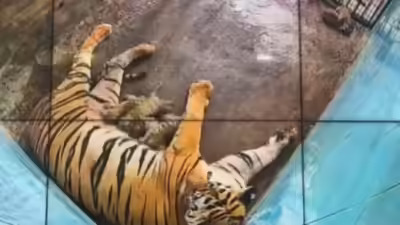
Zoo Cubs Die
Tragedy as Zoo Cubs Die – The death of cubs in a zoo is always a deeply emotional event, sparking concern about animal welfare, accountability, and the ethics of captivity. The recent incident in which zoo-born cubs died has once again brought the spotlight to wildlife management practices in India. This article provides a detailed look at the tragedy, its causes, the aftermath, and the broader implications for conservation and animal rights.

Zoo Cubs Die Background: A Breeding Program Under Scrutiny
Zoos often celebrate the birth of cubs as a triumph, showcasing their breeding programs as evidence of success in conservation. However, the death of young animals quickly reverses this narrative. In the current case, the cubs’ deaths raise questions not only about veterinary care but also about zoo management, habitat conditions, and whether breeding in captivity is being conducted responsibly.
Reports indicate that the cubs were part of a larger breeding effort meant to strengthen the genetic diversity of endangered species. While such initiatives can contribute to conservation, they also bring immense responsibility. Every birth in captivity represents both hope and risk.
Zoo Cubs Die : Possible Causes of Death
The zoo management has cited several potential factors that may have contributed to the deaths:
- Health Complications – Cubs are highly vulnerable in their early weeks, with weak immune systems that can easily succumb to infections.
- Nutrition Issues – Questions have been raised about whether the mother received adequate nutrition during pregnancy and lactation.
- Environmental Stress – Poorly maintained enclosures with inadequate temperature control or exposure to human disturbance can stress both mothers and newborns.
- Veterinary Negligence – Critics argue that slow medical response or lack of specialized neonatal veterinary facilities may have worsened the situation.
An official investigation is now underway to determine the exact cause, but the tragedy has already shaken public trust.
Zoo Cubs Die : Public Outcry and Animal Rights Advocacy
The deaths have triggered widespread public outrage, with animal rights groups calling for stricter regulations and accountability. Social media platforms are filled with anger and grief, demanding answers from zoo authorities.
Organizations such as PETA India and local wildlife NGOs have demanded:
- An independent inquiry into the incident.
- A comprehensive audit of zoo facilities.
- Suspension of breeding programs until proper safeguards are guaranteed.
Advocates argue that zoos often prioritize tourism revenue over animal welfare, turning living beings into exhibits rather than treating them as part of serious conservation initiatives.
Zoo Cubs Die : The Role of Zoos in Conservation: A Debate
This incident revives the ongoing debate about the role of zoos in conservation. Supporters claim that zoos are critical for preserving endangered species, providing education, and conducting research. However, critics counter that captive breeding often fails to ensure long-term survival in the wild and may expose animals to unnecessary suffering.
Key questions include:
- Should zoos focus on animal display or conservation?
- Are resources better spent on protecting natural habitats rather than breeding in captivity?
- How can animal welfare be ensured in facilities that also cater to tourism?
Zoo Cubs Die Case Studies: Similar Incidents in the Past
Unfortunately, this is not the first case of zoo cubs dying prematurely. Across India and the world, several similar incidents have been reported:
- Lion Cubs in Etawah Safari Park (Uttar Pradesh) – Multiple cubs died in 2021 due to health complications, sparking criticism of poor medical facilities.
- White Tiger Cubs in Nandankanan Zoo (Odisha) – Deaths in previous years were attributed to infection and inadequate monitoring.
- International Cases – Even reputed zoos in Europe and the US have faced similar tragedies, proving that the challenge of raising cubs in captivity is global.
These recurring stories highlight systemic issues in zoo management.
Zoo Cubs Die : Impact on Zoo Reputation and Tourism
Zoos rely heavily on public goodwill and visitor trust. Incidents of animal deaths not only tarnish reputations but can also affect visitor numbers. A zoo that is seen as unsafe or negligent risks losing its credibility as a conservation and educational institution.
Tourism experts believe that transparent communication and visible corrective measures will be essential for rebuilding trust. Silence or evasion will only deepen public anger.
Zoo Cubs Die : Legal and Administrative Responses
The deaths have prompted intervention from both local authorities and national regulatory bodies. The Central Zoo Authority (CZA), which oversees zoos in India, has requested a detailed report from the management. Depending on the findings, the zoo could face:
- Monetary penalties.
- Suspension of certain programs.
- Mandatory upgrades to veterinary infrastructure.
- Staff accountability measures, including suspensions or retraining.
The case also raises the possibility of new regulations mandating independent veterinary oversight of breeding programs.
Zoo Cubs Die : Animal Welfare Standards in Indian Zoos
Indian zoos are governed by the Wildlife Protection Act, 1972, and guidelines from the Central Zoo Authority. However, implementation often varies widely, with smaller or underfunded zoos struggling to meet required standards.
Challenges include:
- Inadequate veterinary staff.
- Limited funding for infrastructure upgrades.
- Overcrowding of animals.
- Poor environmental enrichment for captive species.
Unless systemic reforms are enacted, tragedies like this may continue.
Zoo Cubs Die : Public Health and Safety Angle
Animal deaths in captivity also raise public health concerns. If cubs die due to infectious diseases, there is always the risk of zoonotic spillover. Investigations must therefore assess whether adequate biosecurity measures were in place to protect both animals and human visitors.
Expert Opinions
Dr. Meera Sharma, a wildlife veterinarian, notes:
“The neonatal mortality rate in captive cubs is high, but many deaths are preventable with proper monitoring, nutrition, and veterinary facilities. The issue is often not lack of knowledge, but lack of consistent application.”
Ravi Menon, an animal rights activist, argues:
“We must rethink the very purpose of zoos. If cubs are born only to die due to negligence, then the justification of conservation collapses.”
Possible Reforms and Recommendations
To prevent future tragedies, experts recommend:
- Specialized Veterinary Facilities – Dedicated neonatal care units in all major zoos.
- Regular Independent Audits – External monitoring of breeding programs.
- Community Transparency – Timely public disclosure of incidents and corrective actions.
- Focus on Habitat Conservation – Redirecting resources toward protecting wild habitats rather than only breeding in captivity.
Conclusion: A Wake-Up Call for Zoos
The deaths of zoo cubs are not just isolated tragedies; they are indicators of systemic gaps in wildlife management, veterinary care, and ethical oversight. While the loss of young life is heartbreaking, it also provides an opportunity for reform.
If zoos are to justify their existence as conservation centers rather than tourist attractions, they must embrace higher standards of care, transparency, and accountability. Only then can they prevent such tragedies from recurring — and truly serve as sanctuaries for endangered species rather than prisons of neglect.




